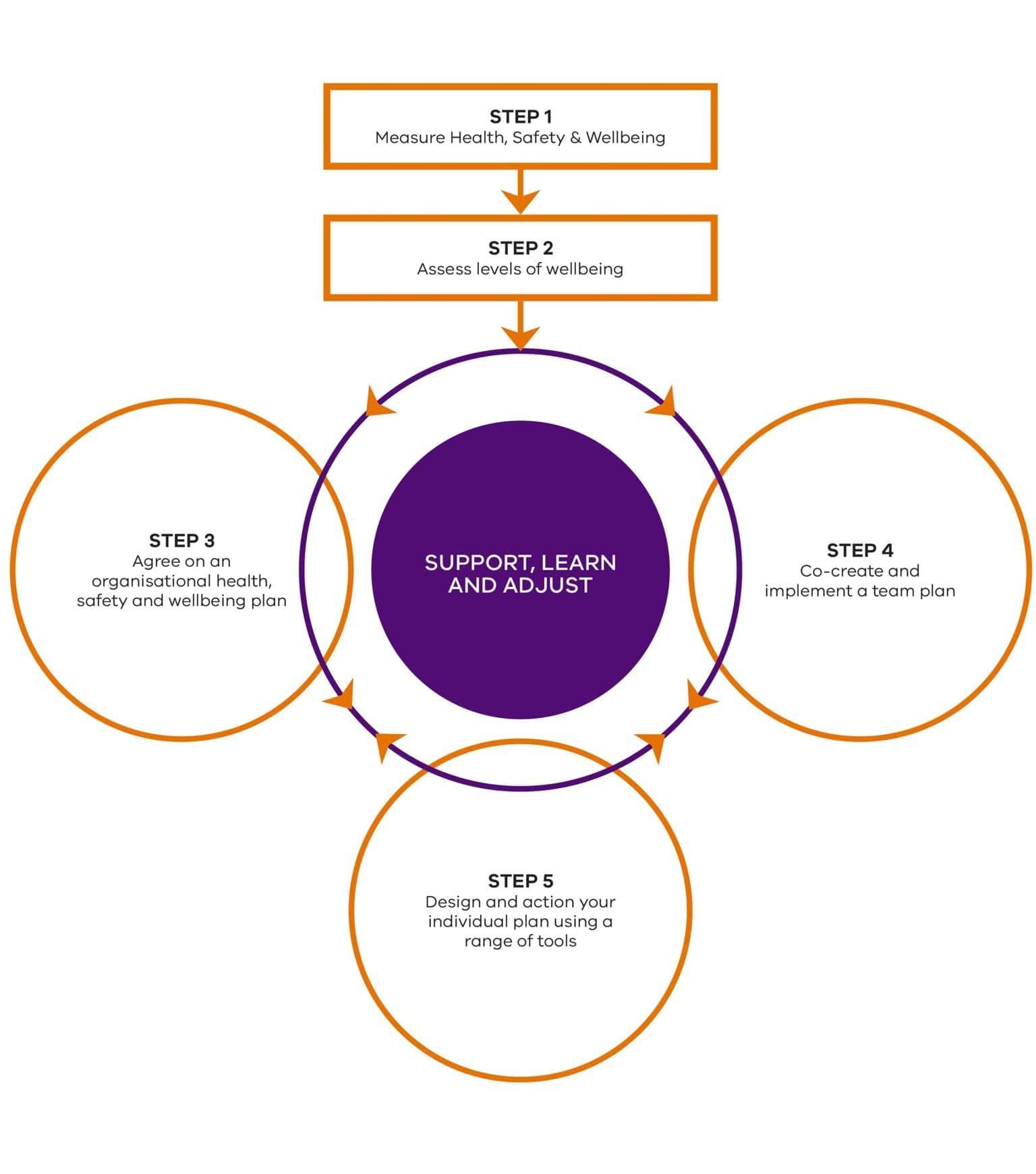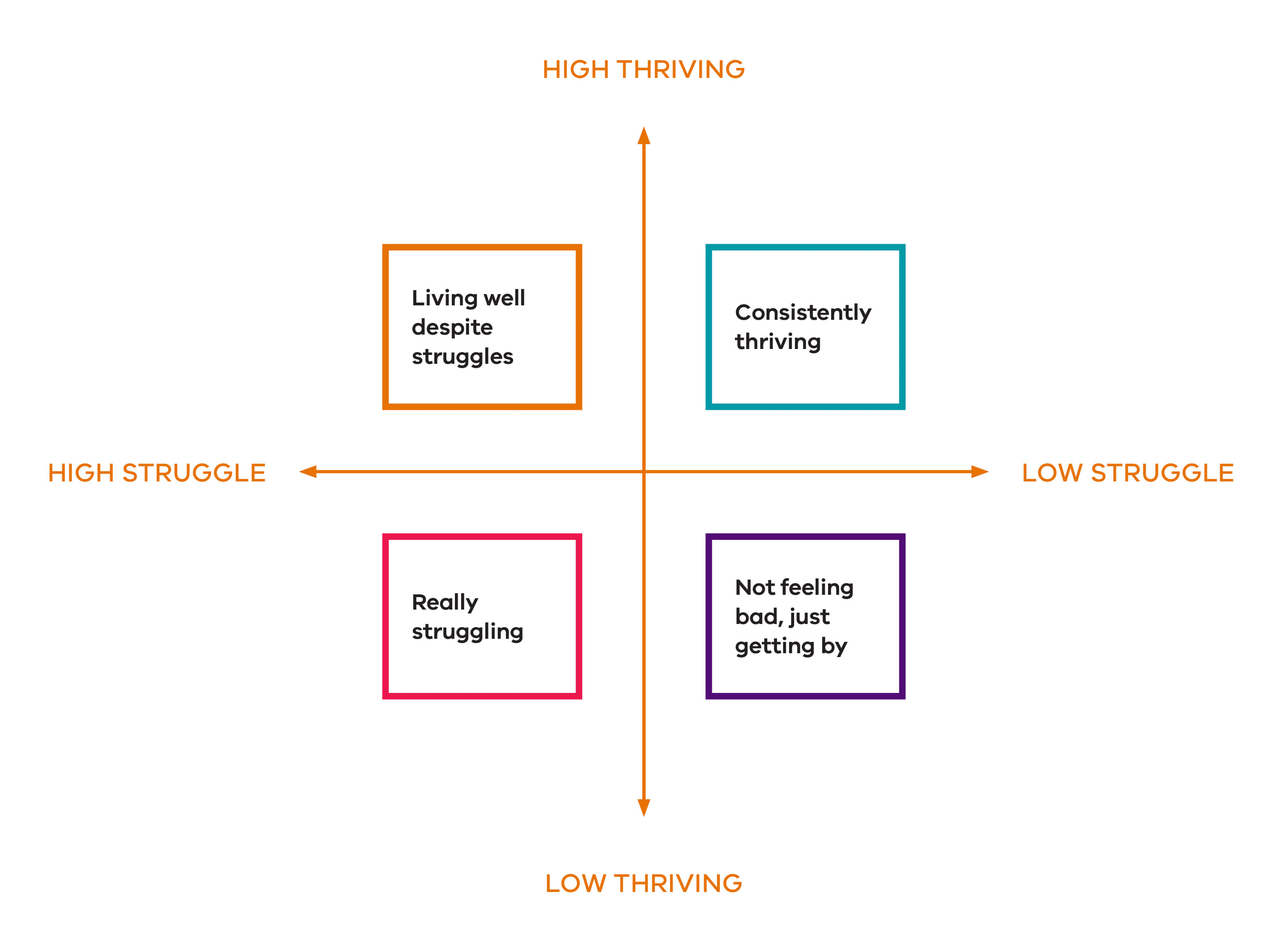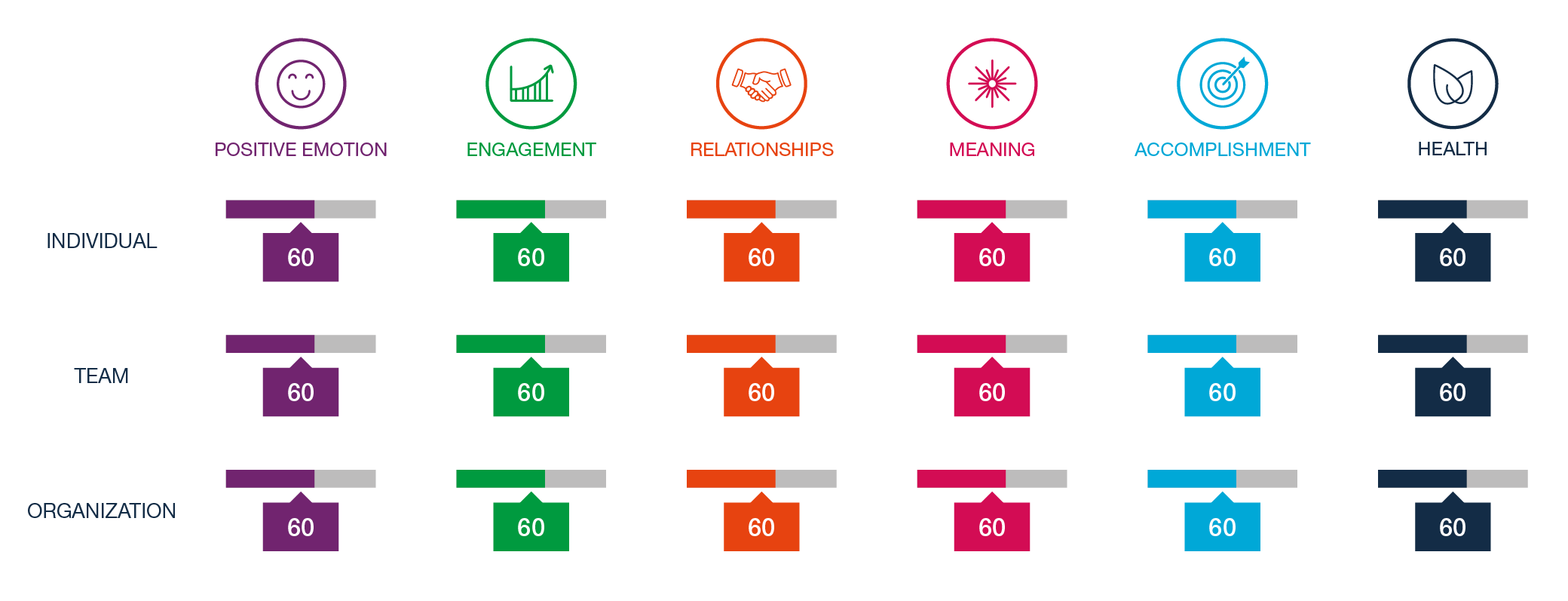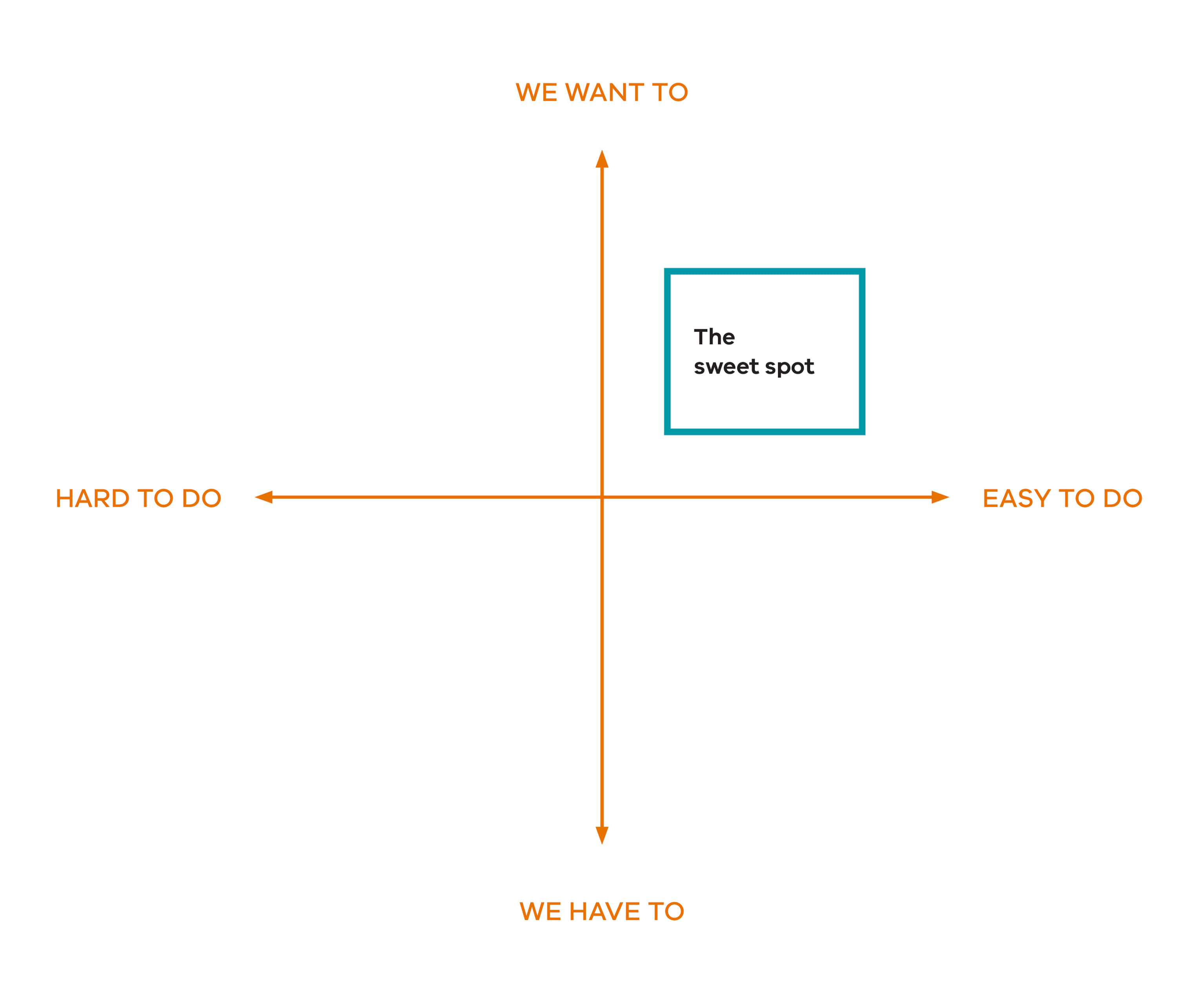Overview
Organisational health, safety and wellbeing initiatives help to foster healthier, safer and more sustainable workplaces. The World Health Organisation defines a safe and well workplace as being 'one where workers and managers work collaboratively to use a continual improvement process to protect and promote the health, safety and well being of all workers and the sustainability of the workplace'. In its simplest form, wellbeing is the ability to thrive, to feel good and effectively function physically, mentally, and socially while navigating the highs and lows that everyone experiences at work and in life. Every organisation has a duty under the Victorian Occupational Health and Safety (OH&S) Act 2004 to have policies and practices in place to keep the workforces safe, reduce risk and prevent injury.
This online guide supports the health, safety and wellbeing of the family violence, sexual assault, and prevention workforces. Having a collective health, safety and wellbeing focus enables workers to take a person-centered approach that keeps victim survivors safe and supports perpetrator accountability. It also allows organisations to support staff retention, reduce absenteeism, boost engagement and address the risks of mental or psychological injury.
In the context of family violence, sexual assault, and prevention services, best practice organisational health, safety and wellbeing approaches include access to regular supervision, communities of practice, Employee Assistance Programs or other external support and collective advocacy.
The Government acknowledges the strength, professionalism and commitment of the family violence, sexual assault and prevention workforces. They are highly motivated to use their skills and expertise to advocate for systemic change towards a more inclusive, safe and equitable society. Supporting the wellbeing of your workforce ensures that the sector can continue to do this essential work.
Organisations, teams and individuals must work collaboratively to care for workforce health, safety and wellbeing, it cannot be done alone. It starts with leaders prioritising their own wellbeing and acting as role models within their organisations. It also requires a commitment to having organisational systems, processes and cultures that promote and protect the health, safety and wellbeing of employees.
The following workplace factors when present, contribute to positive health, safety and wellbeing. They can be grouped into levels, which are mutually reinforcing. Workplace wellbeing initiatives should ideally target activities across all these levels:
- organisation – shared vision, ethics and standards, clear policies and procedures, a focus on organisational change and climate and compliance with relevant legislation
- leadership – proactively support and encourage workplace health, safety and wellbeing and leaders receive training about workplace wellbeing
- job design – role clarity, up-to-date work plans, manageable workloads and consideration of impacts of ongoing exposure to family violence and sexual assault
- team and work group – collective care and psychological safety within teams, collaborative team work and access to professional development
- individual – collective focus on workers feeling valued and that they belong, access to formal and informal support and supervision.
The organisational capacity and commitment to align to the Multi-Agency Risk Assessment and Management (MARAM) Framework is a critical enabler for supporting sustainable health, safety and wellbeing of its workforce. MARAM provides guidance on individual and agency responsibilities and inputs to achieving consistent, collaborative and coordinated system wide practice. Responsibility and role clarity, alongside strong processes for multi-agency practice, can provide a more supportive and rewarding working environment. Embedding MARAM internally to working practices also provides support for the workforce health, safety and wellbeing where a staff member is experiencing or using family violence.
The MARAM organisational embedding guide supports organisational leaders in the process of aligning to MARAM. It outlines the responsibility of organisations to have robust policies and procedures, which in-turn will support the mutually reinforcing categories listed above.
An Organisational health, safety and wellbeing (HSW) self-assessment tool has been developed by Safe and Equal to support workplaces to assess structural factors that impact on health, safety and wellbeing and determine priority actions. It can be used in tandem with the Family Violence Workforce Health, Safety and Wellbeing Guide (the Guide).
This tool is complementary but different to:
- the MARAM alignment organisational self-audit tool which helps organisations identify key areas of alignment and the steps needed to achieve alignment with the MARAM framework
- the Code of Practice: Principles and Standards for Specialist Family Violence Services for Victim Survivors audit tool which assists family violence services to evidence and rate their performance against the standards and high-level indicators of the Code. Indicator 9.2 – The service is committed to supporting staff health and wellbeing being especially relevant.
The Organisational HSW self-assessment tool therefore provides evidence against the Code of Practice indicators and the Human Services Standards.
The Guide is a validated method to measure health, safety and wellbeing, while the Organisational HSW self-assessment tool and tool handbook is a precursor activity that provides foundational information about the organisation wide context.
Further resources and initiatives will be co-developed with the sector, over time to promote workforce health, safety, and wellbeing across all organisational wellbeing categories.
The Family violence workforce health, safety and wellbeing guide
The Family Violence workforce health, safety and wellbeing guide (the Guide) aims to support and promote the health, safety and wellbeing of the sexual assault and family violence response and prevention sectors. It will provide evidence-based tools and guidance that recognise the health, safety and wellbeing impacts that are experienced by those working in the sector. It supports the creation of inclusive, equitable and safe workplaces and enables practitioners and organisations to become proactive participants in caring for workplace health, safety and wellbeing.
The Guide is intended to complement existing health, safety and wellbeing efforts in workplaces and encourages ongoing collaboration, experimentation, and learning. It can be used alongside the Organisational HSW self-assessment tool and any organisation-wide strategies designed to promote the healthy, safety and wellbeing of workforces.
The Guide will assist organisations to foster workplace cultures where it is safe and acceptable to talk about struggles and receive support without stigma.
The Guide takes a trauma and violence-informed lens to reduce harmful stress and the impacts of vicarious, direct and collective trauma that can be experienced in the family violence, sexual assault and prevention workforces. Trauma and violence-informed practices consider ‘the intersecting impacts of systemic and interpersonal violence and structural inequities on a person’s life.1
The gendered nature of the family violence and sexual assault workforces and the prevalence of violence against women and children means that many practitioners in these sectors will have their own lived experience of violence.
These experiences may raise unique wellbeing issues for professionals in the course of their work and may require tailored support. Organisations will need to consider this in the context of their organisational policies and support services.
This Guide is based on the PERMAH model of wellbeing. The efficacy of the PERMAH approach was demonstrated in Australia's largest workplace wellbeing study (2018-2021), led by the Wellbeing Lab and the University of Melbourne. The approach was endorsed by the Australian Human Resources Institute (AHRI), which sets the industry standard for HR practitioners in Australia.
Although the PERMAH model is not the only evidence-based approach to wellbeing practices, it was chosen because it uses a strengths-based approach. The pillars provide a simplified way to understand, measure and implement practical evidence-based health and wellbeing practices that can be incorporated into existing ways of working.
Who can use this Guide
- Family violence response and the sexual assault organisations
- Family violence primary prevention organisations
- Workers who support family violence programs such as administrative roles, human resources and trainers
- Workers in the Orange Door network.
How to use this Guide
The Guide is built around five steps that organisations, teams and individuals can undertake to improve workforce health, safety and wellbeing. These steps are outlined in the diagram below. The process is often experimental, involving trial and error. Just as going for one short run won’t suddenly make you fit, one-off health and wellbeing activities are unlikely to help you to thrive for very long. Caring for wellbeing requires a commitment to learning what works best for your organisation, team and individual wellbeing. As organisations use the Guide, it is important to continually support one another, learn from experience, and adjust for continual improvement.
The Department of Families, Fairness and Housing is providing the PERMAH survey for organisations to use. The survey was developed by the University of Melbourne to better understand the factors that support and undermine workplace wellbeing. One of its strengths is it can generate individual, team and organisational wellbeing reports.
Organisations may set up a working group to consider the aggregated and de-identified wellbeing survey results, go through the Organisational HSW self-assessment tool and to help inform an organisational health, safety and wellbeing plan. The working group may also be able to support teams and individuals while they implement their plans and experiment with the 'fit-for-purpose' health, safety and wellbeing resources, which will be co-developed with the sector, building a useful evidence base over time.
The working group could comprise representatives from across the organisation, including:
- leadership staff
- practitioners/workers
- administrative staff
- corporate staff including education and training, policy, communications, or advocacy roles.
What to do if you need immediate support
Caring for wellbeing and promoting good mental health is essential in all workplaces. The family violence, sexual assault and prevention sectors face unique challenges, which may take a mental, emotional, and physical toll on health.. Some challenges can be related to working in an area in which the workforce is deeply aware of broader social and gender-based inequalities.
Be aware of your own, your colleagues and your staffs’ wellbeing. It is essential that we take care of one another. Working in solidarity and fostering a supportive environment, helps to contribute to the sustainability of the family violence, sexual assault and prevention workforce and dismantle the oppressive structures that contribute to family violence. It’s important to reach out to someone when you’re struggling. This could be your manager, your supervisor, a friend or colleague, a counsellor or psychologist or another support person.
You can also access your employee assistance program (EAP), participate in supervision, or speak with colleagues in a community of practice. For after-hours support, the 1800RESPECT telephone and online counselling services are available 24 hours a day for professionals to discuss the personal impact of working with people who have experienced violence or have used violence.
Support your staff and colleagues by ‘checking in’ regularly. Determine how they are coping and encourage them to seek assistance if needed.
Get in touch
We would like to hear your feedback on this Guide, as well as actions you are currently undertaking within your workplace that are working well. By sharing your resources on this website, we can share a variety of strategies that you can use in your organisation. Please get in touch with us by emailing the Family Safety Victoria Centre for Workforce Excellence.
The Victorian Government is committed to providing a website that is accessible to the widest possible audience, regardless of technology or ability. This page may not meet our minimum WCAG AA accessibility standards.
If you are unable to read any of the content of this page, you can contact the content owners for an accessible version:
Contact email: cwe@dffh.vic.gov.au
Footnotes
- Varcoe, C M, Wathen, C N, Ford-Gilboe, M, Smye, V and Browne, 2016, VEGA Briefing note on trauma- and violence-informed care, VEGA Project and PreVail Research Network, Ottawa, page 1.
- The Wellbeing Lab, (2020). The Wellbeing Lab 2020 Australian Workplace Report. Retrieved from: thewellbeinglab.com/workplacereport
- Fogg, B. J. (2019). Tiny Habits: The Small Changes That Change Everything. New York, NY: Houghton Mifflin Harcourt.
- Thaler, R. H., & Sunstein, C. R. (2009). Nudge: Improving decisions about health, wealth, and happiness. New York, NY: Penguin.
- Wasco, S. M., & Campbell, R. (2002). A multiple case study of rape victim advocates’ self-care routines: The influence of organizational context. American Journal of Community Psychology, 30(5), 731–760.
- Reynolds, V. (2019). The Zone of Fabulousness: Resisting vicarious trauma with connection, collective care and justice-doing in ways that centre the people we work alongside. Context. August 2019, Association for Family and Systemic Therapy, UK, 36-39.
Updated



